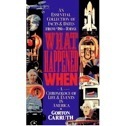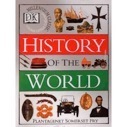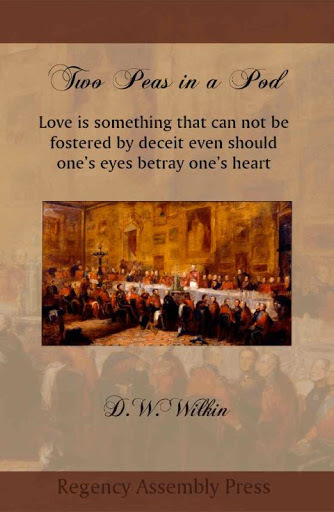A Regency Era Timeline 1810 in progress
Timeline
Each time I start a year, I have already compiled a list, months ago with about 6000 entered of what happened from 1788 to 1837. My first step now (It took several trials to get this down to a science) is to cut out the specific year I will work on and paste it into its own spreadsheet to work with. When I worked on the entire spreadsheet, sometimes inserting a line, with all the graphics I had begun to place, took a long time. Working on each year alone, is a lot faster.
With the year separated out, I now turn to my book sources,
The Timetables of History by Grun and Stein
Chronology of CULTURE by Paxton and Fairfield
 What Happened When by Carruth.
What Happened When by Carruth.
 , History of the World. A beautiful Dorling Kindersley book.
, History of the World. A beautiful Dorling Kindersley book.
I now and diligently look through each of these to find entries that I did not come across on the internet, and other printed lists. It is possible that there are places that have more listings for each year. I have not found them. And when you go to the Timelines at the Regency Assembly Press page, there you will see all the graphical references as well. Something that I did not find anywhere else.
Here is the start of 1810:
Year
Month Day
Event
1810
Jan 10
French church annulled the marriage of Napoleon I & Josephine.
1810
January
January: Based on a minor technicality, the marriage of Napoleon and Joséphine is annulled. Though he claims to still love her, he needs an heir and she has not been able to produce one.
1810
January
January: British portrait painter John Hoppner dies at age 51.
1810
Feb 20
Andreas Hofer (42), military leader (fought Napoleon’s France), was executed.
1810
Feb 28
The 1st US fire insurance joint-stock company was organized in Philadelphia.
1810
Mar 1
Frederic Chopin (d.1849), Polish composer and pianist, was born. He studied in Poland but spent most of his adult life in Paris. He met George Sand in Paris in 1838 and they were together until 1847. His works include the Waltz #2 in C# Minor (1835).
1810
Mar 2
Leo XIII (Vincenzo G Pecci), 256th Catholic Pope (1878-1903), was born.
1810
Mar 6
Illinois passed the 1st state vaccination legislation in US.
1810
Mar 10
John McCloskey, president of St. Johns College, was born.
1810
Mar 11
Emperor Napoleon of France was married by proxy to Archduchess Marie Louise of Austria.
1810
March
March: Napoleon marries Archduchess Marie Louisa of Austria, daughter of Austrian emperor Francis I.
1810
Apr 17
Lewis Norton of Troy, PA., introduced his pineapple cheese.
1810
April
April: Beethoven composes “Für Elise” (Bagatelle in A minor)
1810
May 3
Lord Byron swam the Hellespont.
1810
May 9
Louis Gallait, historical painter, was born.
1810
May 21
Charles Chevalier d’Eon de Beaumont (81), French spy, cross dresser, died.
1810
May 23
Margaret Fuller (d.1850), American social reformer, writer and critic, was born. She was the first female journalist for the New York Tribune. “Man is not made for society, but society is made for man. No institution can be good which does not tend to improve the individual.”
1810
May 25
Argentina declared independence and began its revolt from Napoleonic Spain.
1810
May 29
Erasmus Darwin Keyes (d.1895), Major General (Union volunteers), was born.
1810
May 29
Solomon Meredith (d,1875), Bvt Major General (Union volunteers), was born.
1810
May
May: In the May Revolution, Armed citizens of Buenos Aires expel the Viceroy from Spain, declare their independence, and establish a provincial government for Argentina.
1810
May
May: While on his Grand Tour, 22-year old Lord Byron swims across the Hellespont (Dardanelles) in a romantic imitation of the mythical Leander, who swam the mile and a half each night to be with his lover, Hero.
1810
Jun 8
Robert Schumann (d.1856), German composer, was born in Zwickau, Germany.
1810
Jun 9
Carl Otto Ehrenfried Nicolai, composer (Merry Wives of Windsor), was born.
1810
Jun 23
John Jacob Astor (1763-1848) organized the Pacific Fur Co. in Astoria, Oregon.
1810
Jul 5
P.T. Barnum (d.1891), American showman who formed the Barnum and Bailey Circus, was born. Years before founding the famous circus that bears his name, Barnum was recognized as the greatest showman and museum-owner of his time. Barnum’s goal was to attract attention, and it never bothered him if the wonders he exhibited in his New York American Museum were genuine or fake. Barnum opened the American Museum on Broadway in 1842, luring in customers by installing festive flags and New York’s first revolving spotlight on the roof of the building, both visible in this contemporary engraving. Abandoning the high-minded tone of most other museums, Barnum attracted huge audiences with marvels like the Feejee Mermaid, a grotesque composite of the top half of a monkey and the bottom half of a fish, and General Tom Thumb, a 25-inch-tall dwarf.
1810
Jul 20
Colombia declared independence from Spain.
1810
July
July: Columbia declares independence from Spain.
1810
July
July: Napoleon annexes the Kingdom of Holland following the abdication and flight of his brother Louis Bonaparte, who has been king since 1806 but refused to join the emperor’s Continental System.
1810
Aug 10
Camillo di Cavour, helped bring about the unification of Italy under the House of Saxony.
1810
Aug 14
Samuel Sebastian Wesley (d.1876), English composer, was born in London.
1810
Aug 21
Sweden’s Riksdag elected Jean-Baptiste Bernadotte, Marshal of France under Napoleon, as heir apparent to the Swedish throne.
1810
Aug 24
Theodore Parker, anti-slavery movement leader, was born.
1810
Aug 29
Juan Bautista Alberdi (d,1884), Argentine politician, writer, was born.
1810
August
August: Napoleonic general Jean Baptiste Jules Bernadotte is elected as Crown Prince of Sweden.
1810
Sep 4
Donald McKay, US naval architect, built fastest clipper ships, was born.
1810
Sep 16
In Mexico Father Miguel Hidalgo-Costilla delivered the cry for freedom in front of a small crowd of his parishioners (The Grito de Dolores). This action stemmed from meetings of the literary and social club of Queretaro (now a central state of Mexico), which included the priest, the mayor of the town, and a local military captain named Ignacio Allende. They believed that New Spain should be governed by the Creoles (criollos) rather than the Gachupines (peninsulares). Rev. Hidalgo was joined by Rev. Jose Maria Morelos. Both priests were later executed by firing squads. When Mexico revolted the Spanish settlements began to fall apart. Under Mexican rule the missions were secularized and the huge land holdings were broken up.
1810
Sep 18
Chile declared its independence from Spain (National Day). Bernardo O’Higgins helped lead Chile to independence.
1810
September
September: A disagreement over troop deployment between George Canning, British Secretary of State for Foreign Affairs, and Lord Castlereagh, the Secretary of State for War, ultimately leads to a duel. Canning, who had never fired a pistol, misses; Castlereagh wounds him in the thigh.
1810
September
September: Chile declares independence from Spain.
1810
Oct 4
Alexander Walewski, French earl, foreign minister, son of Napoleon I, was born.
1810
Oct 8
James Wilson Marshall, discoverer of gold in California, was born.
1810
Oct 12
Bavarian Crown Prince Ludwig, later to become King Ludwig I, was married to Princess Therese of Saxony-Hildburghausen. In honor of the wedding a horse race took place at the Theresienwiese (the Theresien meadow). The decision to repeat the horse races in subsequent years gave rise to the tradition of the Oktoberfest.
1810
Oct 16
Rabbi Nachman (b.1772) of Bratslav died and was buried in Uman, Ukraine. Nachman was renowned for his mystical interpretations of Jewish texts and his belief that higher spirituality could be achieved through a combination of prayer, meditation and good deeds. On his deathbed, he is said to have promised to be an advocate for anyone who would come and pray beside his tomb.
1810
Oct 19
Cassius Marcellus Clay (d.1903), Major General (Union volunteers), was born.
1810
Oct 27
US annexes West Florida from Spain.
1810
October
October: Wellington prevents French forces under Marshall Masséna from capturing Lisbon by staging a successful rearguard action at Torres Vedras.
1810
Nov 2
Andrew Atkinson Humphreys (d.1883), Mjr. Gen. (Union volunteers), was born.
1810
Nov 18
Asa Gray (d.1888), American botanist, was born. He wrote “Gray’s Manual.”
1810
Nov 30
Oliver Fisher Winchester, rifle maker, was born.
1810
November
November: Painter Johann Zoffany dies at age 77.
1810
November
November: The death of Princess Amelia sends George III into another bout of mental illness.
1810
Dec 7
Theodor Schwann, German physiologist, was born.
1810
Dec 22
British frigate Minotaur sank killing 480.
1810
Dec
Gen. Andre Rigaud (1761-1811) returned to Haiti yet a third time, establishing himself as President of the Department of the South, in opposition to both Alexandre Petion and Henri Christophe.
1810
December
December: English prizefighter Tom Cribb defends his world bareknuckle championship at Copthall Common, in Sussex, against American-born ex-slave Tom Molineaux, drawing over 10,000 spectators. Cribb is declared the winner after 34 rounds.
1810
December
December: The HMS Minotaur, a 74-gun ship of the line, strikes a bank and goes down off the coast of the Netherlands. 480 crew members are lost.
1810
1810
Princess Amelia, youngest child of George III, was said to be his favorite. His grief over her death in 1810 at age 27 is believed to have brought on his final bout of madness.
1810
The famous Portland Vase is given to the British Museum, on permanent loan from the Duke of Portland. (It will be purchased by the museum in 1945.)
1810
The Portland Vase. The first century BC Roman cameo glass vase served as an inspiration to many glass and porcelain makers, especially Josiah Wedgwood, since it was first brought to England by Sir William Hamilton in 1784.
1810
Thomas Love Peacock’s Genius of the Thames: a Lyrical Poem is published.
1810
Walter Scott’s narrative poem, The Lady of the Lake, is published.
1810
Allied with the Portuguese against Napoleon, the British negotiate an agreement with the Portuguese calling for the gradual abolition of the slave trade across the South Atlantic.
1810
People have been migrating from the United States into West Florida. These settlers rebel and declare independence from Spain. Recognizing Spain’s weakened condition from occupation by Napoleon, the U.S. President James Madison and Congress declare the region for the United States — a move not recognized internationally.
1810
Cornelius Vanderbilt (1794-1877), at the age of 16, starts a business transporting people and then freight across the Hudson River and New York’s harbor in a small, two-masted sailboat. A revolution in transportation was about to begin and as an entrepreneur he would be a part of it.
1810
The ruler of Kauai cedes his island to Kamehameha. Kamehameha is now ruler of all of the Hawaiian Islands. In accordance with Hawaiian tradition he is considered divine and commoners prostrate themselves before him.
1810
The Maryland legislature authorizes a lottery for the erection of a memorial to George Washington, a 188 foot Doric column in Baltimore’s Mt Vernon Place.
1810
Ephraim Basher (b.1744), NYC silversmith, died. He marked his pieces “EB” inside a square or an oval.
1810
Salzburg, Austria was annexed by Bavaria during the Napoleonic Wars and the Univ. of Salzburg was suspended.
1810
In Bristol, England, the Commercial Rooms were constructed under architect C.A. Busby.
1810
The British Bullion Committee pronounced that it was folly to let governments print as much money as they wanted and not expect inflation.
1810
Peter Durand, a British merchant, was granted a patent by King George III for his idea of preserving food in “vessels of glass, pottery, tin (tin can), or other metals or fit materials.”
1810
Sake Dean Mahomed founded the Hindoostane Coffee House, London’s first known curry establishment. Born in Patna, India in 1759, Mahomed was also the first known Indian to write a book in English. Published in 1786, it describes his adventures as a soldier with the East India Company’s army, his journey to Europe, his marriage to an Irish woman and their move to London.
1810
The British wrestled Mauritius from France. Indians were brought in as indentured laborers and later waves of Chinese immigrants arrived.
1810
A typhoon devastated the Caroline Islands, 500 miles south of the Marianas. The survivors sailed to Guam but only half survived. Spanish authorities sent the Carolinians to Saipan and Tinian to manage the Spanish cattle herds.
1810
A German folk tale appeared in “Gespensterbuch” (The Book of Ghosts), which formed the basis for the 1821 opera “Der Freishutz” (The Free-Shooter) by Carl Maria von Weber. In 1991 American writer William Burroughs wrote “The Black Rider,” an English version of the story with music by Tom Waits.
1810
In Germany Friedrich Wilhelm III began the construction of Museum Island in Berlin.
1810
In Germany construction of the first brew kettle at the Hallerbräustadel, the “factory,” as it is called in the books, that Gabriel Sedlmayr leased in 1808 at the west end of the Neuhauserstraße. The kettle is only used to refine vinegar. Today at this site stands the Hertie department store.
1810
Wilhelm von Humboldt founded Humboldt University in Berlin to give students a broad humanist education.
1810
Juan Jose de los Reyes Martinez, miner and revolutionary hero (El Pipila), joined some 20,000 rebels who stormed Guanajuato, Mexico, and cornered Spanish colonists inside a granary. Martinez set fire to the granary and died in the flames.
1810
Saartjie Baartman (~21) left South Africa with 2 white men who promised to make her rich. [see 1816]
1810
In Spain General Count Hugo, the father of Victor Hugo, governed Central Spain during the Peninsula War. He exterminated guerrillas and nailed up their severed heads.
1810-1811
The Duke of Wellington has the Lines of Torres Vedras heavily fortified and blocks all French movement forcing them to slow starvation during this winter. The resulting French retreat is considered the turning point of the Peninsular Campaign.
1810-1813
Boston-based whalers slaughtered an estimated 150,000 fur seals on the Farallon Islands, 28 miles west of San Francisco. Russian hunters followed and occupied the islands for the next 25 years during which they wiped out the remaining fur seals. Fur seals began to return around 1977, but their first pup wasn’t born until 1996.
1810-1832
The 54-mile Göta Canal was built to connect Sweden’s east and west coasts to circumvent Danish shipping controls between the Baltic and North Seas. The project was conceived and led by Count Baltzar von Platen (d.1830).
1810-1857
Alfred de Musset, French author: “How glorious it is — and also how painful — to be an exception.”
1810-1860
Theodore Parker, American religious leader: “Religion without joy—it is no religion.”
1810-1862
The Regency Period in English architecture. Oriental curves and cupolas influenced English architecture.
1810-1891
PT Barnum (Phineas Taylor Barnum), US showman and founder of “The Greatest Show On Earth.” He established his circus in 1871. He served in the Connecticut State House of Representatives for 2 terms, was mayor of Bridgeport, and was the first president of Bridgeport Hospital. “More persons, on the whole, are humbugged by believing nothing, than by believing too much.”
1810-1893
Ferenc Erkel, Hungarian composer, founder of the Nationalist school. His works include The Festive Overture.
That’s right, today is the first week that it is available. Kindle’s today, and then in a week or so, you can have it in your hands physically if you so desire in Trade Paperback form as the other releases from our publisher, Regency Assembly Press does.
This release the publisher is trying out the Kindle Select program so it is exclusive to Amazon for 90 days. What that means for you, a reader, is that should you have
1) a Kindle
2) Are a member of Amazon Prime
then you can borrow the book, free to you, and try before you buy (always, please buy.)
For myself and Regency Assembly Press it is an experiment. RAP (And we hope you all are RAPpers and not RAPscallions) wants to see if this will work. They have also reduced the price of this book to half of what RAP books sell for. $3.99 for an electronic copy.
If you do not have an actual Kindle, Amazon has made it possible to read this book on virtually any electronic device. GO HERE if you want to get a copy for something other than a Kindle, or wait patiently until right before Thanksgiving (November 15th) when it will be released in all other digital formats.
Here is a picture, which of course you can click on to go fetch the book:
Love is something that can not be fostered by deceit even should one’s eyes betray one’s heart.
Two brothers that are so close in appearance that only a handful have ever been able to tell them apart. The Earl of Kent, Percival Francis Michael Coldwell is only older than his brother, Peregrine Maxim Frederick Coldwell by 17 minutes. They may have looked as each other, but that masked how they were truthfully quite opposite to one another.
For Percy, his personality was one that he was quite comfortable with and more than happy to let Perry be of a serious nature. At least until he met Veronica Hamilton, the daughter of Baron Hamilton of Leith. She was only interested in a man who was serious.
Once more, Peregrine is obliged to help his older brother by taking his place, that the Earl may woo the young lady who has captured his heart. That is, until there is one who captures Peregrine’s heart as well.
Available in other digital formats on 11/15/2012






